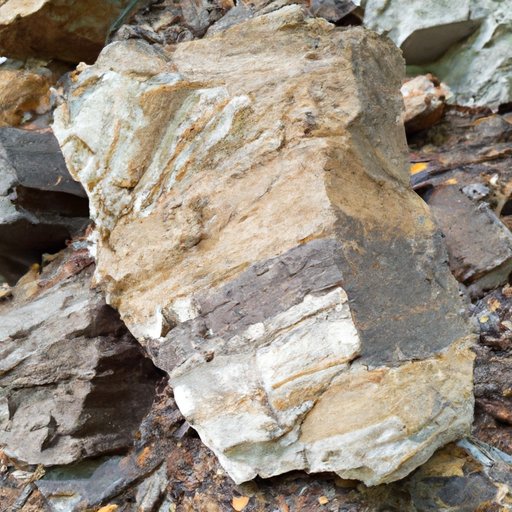Introduction
Sedimentary rocks are a type of rock that form from the accumulation of sediment over time. This sediment can come from a variety of sources, including the weathering of preexisting rocks, the deposition of eroded materials from other sources, and even the remains of organisms. The material that composes these rocks is then cemented together by either chemical or physical processes, creating a solid rock.
The most common types of sedimentary rocks include sandstone, shale, limestone, and conglomerate. Each of these rocks is composed of different materials, depending on the environment they form in. For example, sandstone is composed primarily of quartz and other mineral grains, while shale is made up of clay minerals. Limestone is composed mainly of calcite, and conglomerate is made up of larger particles such as pebbles and cobbles.

Chemistry Behind Sedimentary Rocks and the Materials that Create Them
To understand which substances are most likely to form sedimentary rocks, it’s important to look at the chemistry behind the formation of these rocks. Sedimentary rocks are created when two primary compounds interact: silicate minerals and calcium carbonate. Silicate minerals are made up of silicon and oxygen atoms, while calcium carbonate is composed of calcium, carbon, and oxygen atoms.
These two compounds form the basis of sedimentary rocks because they are both soluble in water. Water helps to dissolve the compounds, allowing them to mix and form a solution. This solution can then be deposited in various environments, where it will eventually become sediment. As the sediment accumulates, it can be cemented together by physical or chemical processes, forming sedimentary rocks.
In addition to silicate minerals and calcium carbonate, there are other substances which contribute to the formation of sedimentary rocks. Clay minerals, organic matter, and iron oxide are all important components of sedimentary rocks. Clay minerals provide structure to the sediment, while organic matter helps bind the sediment together. Iron oxide provides color to the rock and can also act as a binding agent.
Main Components Necessary for Creating Sedimentary Rocks
Silicate minerals are one of the most important components of sedimentary rocks. These minerals are made up of silicon and oxygen atoms, and they help to form the structure of the sediment. Examples of silicate minerals include quartz, feldspar, mica, and olivine. Quartz is the most abundant mineral found in sedimentary rocks, making up around 60% of the total composition.
Calcium carbonate is another important component of sedimentary rocks. This compound is composed of calcium, carbon, and oxygen atoms, and it helps to bind the sediment together. Calcium carbonate is especially important in the formation of limestone, which is composed almost entirely of this compound. Other examples of calcium carbonate-containing sedimentary rocks include travertine and chalk.
Clay minerals are also essential components of sedimentary rocks. These minerals are composed of a variety of elements, including aluminum, silicon, and oxygen. Clay minerals help to give sedimentary rocks their structure, and they are especially important in the formation of shale. Examples of clay minerals found in sedimentary rocks include kaolinite, illite, and montmorillonite.
Organic matter is also important for the formation of sedimentary rocks. This material is composed of the remains of organisms, such as plants and animals. Organic matter helps to bind the sediment together and can also provide color to the rock. Examples of sedimentary rocks containing organic matter include coal and oil shale.
Conclusion
As we have seen, there are a variety of substances that can form sedimentary rocks. Silicate minerals, calcium carbonate, clay minerals, and organic matter are all essential components of sedimentary rocks. By understanding the chemistry behind the formation of these rocks, we can better understand which substances are most likely to form sedimentary rocks.


